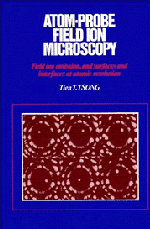 Atom-Probe Field Ion Microscopy
Atom-Probe Field Ion Microscopy 5 - Selected topics in applications
Published online by Cambridge University Press: 30 October 2009
Summary
Observation and analysis of lattice defects
Point defects
The field ion microscope, with its spatial resolution sufficient to resolve atoms in most high index planes of an emitter surface and the capability of reaching into the bulk of the sample by removing surface layers with field evaporation, can be used to observe and analyze intrinsic and extrinsic lattice defects in the sample. The atom-probe, on the other hand can analyze the chemistry of a solid with comparable spatial resolution, and has been actively used to study compositional variations across phase boundaries, in precipitates, and across a grain boundary in impurity segregations, etc. In fact, atom-probe and field ion microscopy is currently the only technique capable of imaging lattice defects and simultaneously analyzing the chemistry of these defects in a solid on an atomic scale. Some of the most actively pursued and important applications in field ion microscopy have been in materials science and physical metallurgy. At least half the papers published in field ion microscopy are concerned with these subjects. As comprehensive reviews of these studies by experts in this field already exist, only selected topics will be briefly discussed here.
The simplest lattice defects as far as FIM observations are concerned are point defects, such as vacancies, self-interstitials and substitutional as well as interstitial impurity atoms. Vacancies invariably show up as dark spots in the field ion images. Other point defects may appear as either bright image spots or ‘vacancies’ in the image. Thus these defects can be identified from field ion images of high index planes where all the atoms in a plane are fully resolved.
- Type
- Chapter
- Information
- Atom-Probe Field Ion MicroscopyField Ion Emission, and Surfaces and Interfaces at Atomic Resolution, pp. 318 - 383Publisher: Cambridge University PressPrint publication year: 1990


